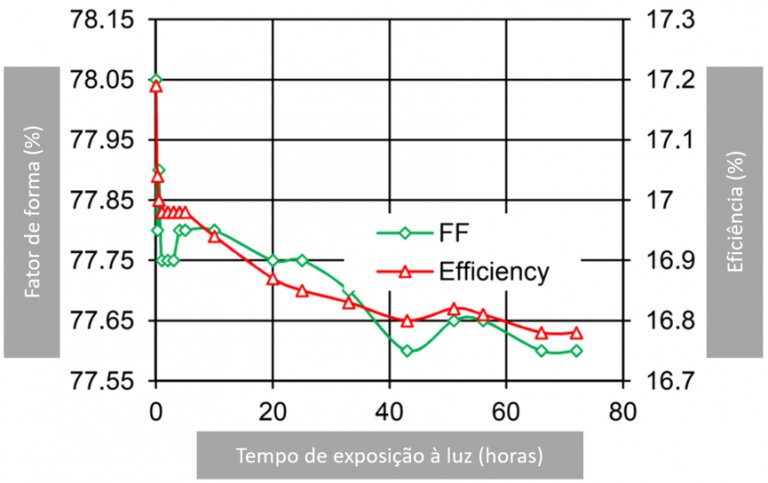Light-induced degradation is a phenomenon that reduces the efficiency of photovoltaic cells upon exposure to light. The phenomenon, generically known as LID (Light Induced Degradation), can have different causes.
Amorphous silicon thin film cells are known to be the most affected by the LID effect. In this type of cell, the so-called Staebler-Wrosnki effect occurs, responsible for the sudden drop (of up to 20%) in the efficiency of the photovoltaic module in the first hours of exposure.
CdTe (cadmium telluride) and CIGS cells suffer from the same problem, but with reduced intensity. Modules based on these cell types undergo initial degradation typically less than 10%.
In photovoltaic cells made of crystalline silicon (poly or mono), which dominate the market, the LID effect is mainly caused by the presence of the boron-oxygen complex, which causes the initial reduction in efficiency between 1% and 4%.
The LID effect in crystalline silicon cells
The exact origin of the degradation of crystalline photovoltaic cells is still the subject of studies. The most accepted model in scientific literature is the boron-oxygen complex. In other words, LID degradation would be caused by oxygen contamination in photovoltaic cells manufactured from P-type wafers (doped with boron).
Recent research points out, however, the existence of the LID effect even in cells produced with other materials (replacing boron), as is the case with cells doped with gallium. There is also evidence that other phenomena (not related to oxygen contamination) may be partially responsible for LID degradation.
The LID phenomenon linked to the boron-oxygen complex, identified as the main origin of the problem, is a short-term phenomenon, which occurs with intensity in the first hours or initial days of exposure of the photovoltaic module to light.
The figure below illustrates the evolution of the LID effect in a crystalline silicon photovoltaic cell, manufactured using the Czochralski process, in an environment with constant oxygen concentration and solar irradiance.

Photovoltaic cells are formed by a silicon PN semiconductor junction. The junction is produced through the silicon doping process. Boron and phosphorus are generally the materials used in the doping process.
The wafers used to manufacture the cells can be doped with boron or phosphorus. This doping occurs during the manufacture of the ingot. In the first case, type P wafers result and in the second case, type N.
The vast majority of photovoltaic cells are produced from P-type wafers. N-type cells, which have recently begun to appear on the market, do not suffer from the boron-oxygen effect, identified as the main responsible for the LID effect in these cells. This was explained in the article “What are N-type photovoltaic cells?”.
In P-type cells, which are still the most common on the market, the boron used in doping can form complexes with oxygen in the presence of light. Boron-oxygen complexes act as recombination centers that cause a reduction in the efficiency of the photovoltaic cell with exposure to light.
Recombination is a physical process that occurs all the time in silicon. When an electron recombines, it is no longer available for the formation of electric current. The recombination centers accelerate this process and the result of this is a reduction in the efficiency of the cell or, in other words, a reduction in the power that the cell can provide for a certain irradiance (intensity of sunlight).
Defects caused by the boron-oxygen complex are one of the main limitations that the industry faces in producing high-efficiency cells from P-type wafers. The LID phenomenon has been most studied in monocrystalline silicon, but is equally observed in polycrystalline cells and in quasi-mono (cast-mono silicon).
Passivated cells (PERC) are particularly subject to a slow and more intense LID effect, known as LeTID or LID2, which is strongly dependent on temperature. The latter is a phenomenon that is still little studied and should lead, in the near future, to changes in the qualification and certification procedures for crystalline modules. N-type cells, with phosphorus-doped ingots, practically do not present this problem.
It is for this reason that the most efficient cells available on the market are N-type, but a large volume of P-type modules are still produced worldwide, as manufacturing N-type wafers requires changes to production lines, which the industry prefers. to postpone.
How the LID effect affects photovoltaic installations in practice
Fortunately, in crystalline modules the LID effect related to the boron-oxygen complex, identified as the main cause of this type of degradation, is a short-lived phenomenon – that is, it occurs in the first hours of exposure of the photovoltaic module to light.
This makes it possible to quantify the effect and discount its influence on the module's certified efficiency. During the certification process, standardized by the international standard IEC 61215, crystalline modules must be subjected to an initial exposure of 5 kWh/m2, that is, they must be subjected to an irradiance of 1000 W/m2 for 5 hours.
This is necessary to stabilize the module's efficiency, allowing the measurement of power and other electrical parameters after the LID effect occurs. Photovoltaic modules purchased on the market are certified by national and international laboratories and organizations.
The modules sold in Brazil are certified in accordance with INMETRO ordinance 004/2011, which follows guidelines from the international standard IEC 61215. As a consequence of this initial exposure to light, the power of the photovoltaic module informed to the consumer is already the power after the effect LID. The main implication that the LID effect brings to the photovoltaic market is that we would be able to produce more efficient modules if the phenomenon did not exist.
References
The performance of photovoltaic (PV) systems. Nicola Pearsall (editor), Woodhead Publishing Series in Energy High-Efficiency Solar Cells. Xiaodong Wang, Zhiming M. Wang (eds), Springer Photovoltaics Fundamentals and Applications, Tom Markvart, Luis Castaner, Elsevier Photovoltaic Solar Energy. Reinders, Verlinden, Sark, Freundlich (eds), Wiley Understanding Light-Induced Degradation of c-Si Solar Cells Bhushan Sopori, DOI: 10.1109/PVSC.2012.6317798 Review of light-induced degradation in crystalline silicon solar cells, Solar Energy Materials & Solar Cells, Elsevier, 2016
















2 Responses
Would the LID effect have any difference from a humid region to a dry region? Does the LID effect occur due to exposure to high humidity accumulated in the panels?
Daniel, the LID effect has to do with the boron-oxygen interaction when cells are exposed to sunlight. In our Advanced Project of DG Solar Power Plants – 5MW Course we explain more about the subject. Know more: https://cursos.canalsolar.com.br/curso/curso-avancado-de-projeto-de-usinas-solares-de-geracao-distribuida-ate-5mw/
Furthermore, the LID effect is smaller in type N modules, which is a technology that is starting to find its way into the market this year. Here is another reference: https://canalsolar.com.br/o-que-sao-as-celulas-solares-fotovoltaicas-do-tipo-n/